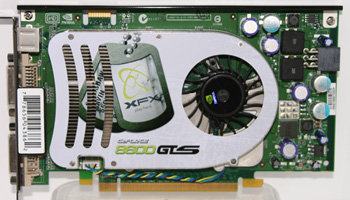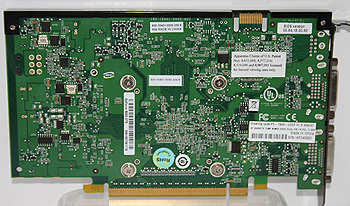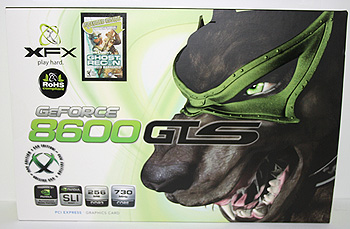XFX GeForce 8600 GTS 256MiB DDR3 PCI-E XXX
XFX's XXX nomenclature is wheeled out to signify inflated clocks over the reference frequencies NVIDIA set out when they create their basic SKUs. A basic, stock GeForce 8600 GTS runs at 675MHz base, 1450MHz shader core, and 1000MHz memory frequency with those DRAMs connecting to two ROP channels and thus a 128-bit aggregate memory bus. XFX run 730/1560/1130 on their XXX GTS, 720/1450/1090 for the slightly slower Extreme version, with a stock clocked version bringing up XFX's 8600 GTS rear. Here's the base spec for the reference hardware:
XFX tart up the reference PCB and cooler design with a brace along the board's spine, their own branding plate and a darker colour for the metal on the backplane, but otherwise things are as NVIDIA intended in their reference design. The board's 187mm long, occupying much the same space as the 7-series GeForce mid-range boards of last generation. You get a one-slot cooler on both the reference hardware and the XFX XXX, with the fan being PWM controlled and making little more than a whisper at idle.
While we don't have numbers we'd like to quote in terms of decibels, the sound it makes is more of a hiss than that output by 8800 GTS and GTX at full chat. Volume isn't huge, but the pitch of the hiss is somewhat annoying when the fan's running flat out. Once everyone's clicked enough ad banners, we'll splash out on an anechoic chamber to do this bit of a board analysis better.
NVIDIA claim 71W max power draw for a GeForce 8600 GTS board at reference clocks, but still outfit it with an external power connector just to be on the safe side. XFX's XXX sports one too of course. Each DVI output on an 8600 GTS is dual-link capable and both links are protected by their own key, feeding an encryption block on the GPU that can handle output over the pair. That means it's the first consumer graphics product that'll let you display protected HD content on a display that requires two links. We'll give that a poke later on.
Each GeForce 8600 GTS with 256MiB of memory has four 64MiB DRAMs, each servicing a 32-bit half of the two ROP partitions in a full G84. They're rated to 1000MHz, and XFX use 1.0ns Samsung parts, which we think everyone else will use too. Of course XFX bump that up by 11 and a bit percent. At stock, that gives G84 32GiB/sec of theoretical memory bandwidth.
Boards support SLI, HDTV out via component given the right cable, slide into a PCI Express slot and will run you a cool $199-229, depending on where you look. Boards like XFX's XXX will cost that little bit more for the extra performance and possible bundle.
XFX ship the XXX with Ghost Recon: Advanced Warfighter to add their value on top of the inflated clocks, and the box art is in their usual style.
We've got no nude die shots this time, while we continue testing. Those will come, for readers eager to see what a 13x13mm² die looks like. The silicon revision is likely A2 and produced in the early weeks of 2007. GeForce 8600 GT is released at the same time, and we have one of XFX's GeForce 8600 GTs in for testing. Let's look at that.




